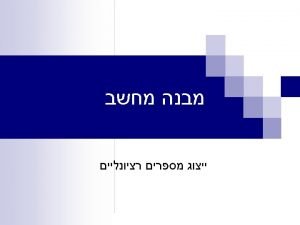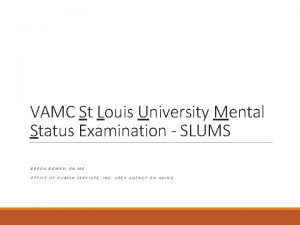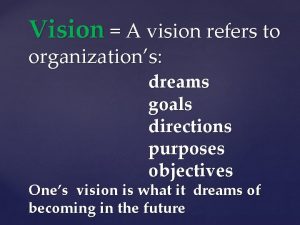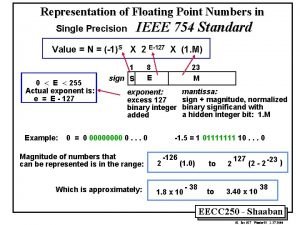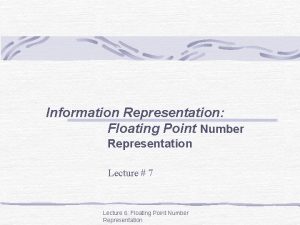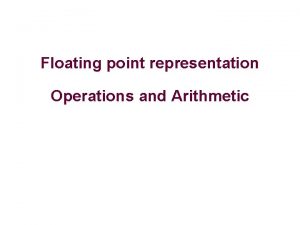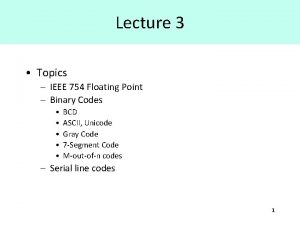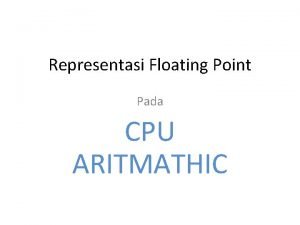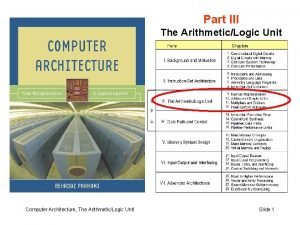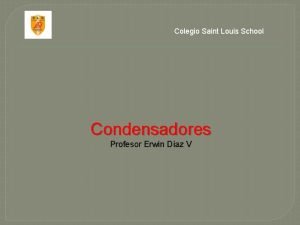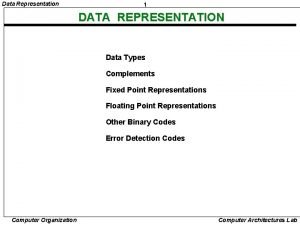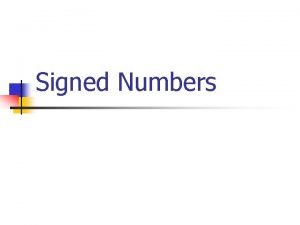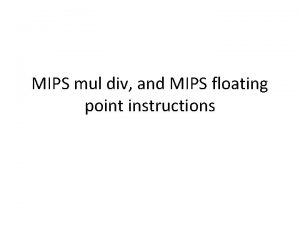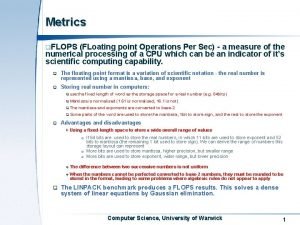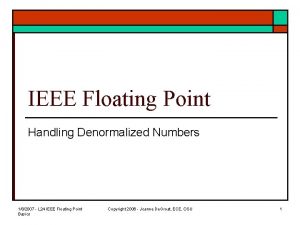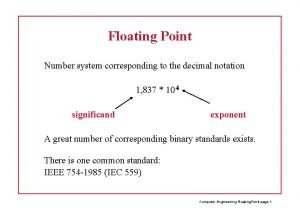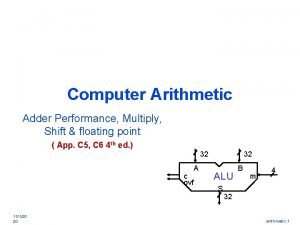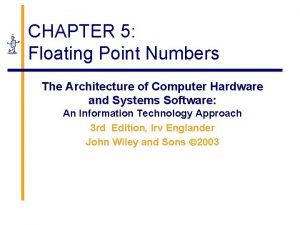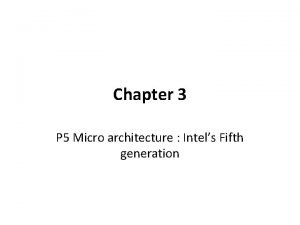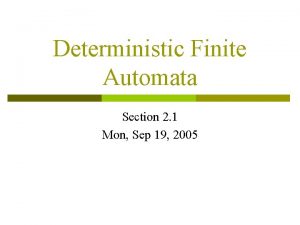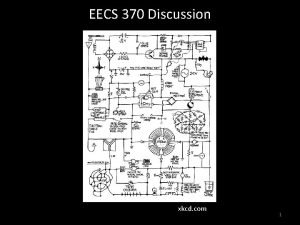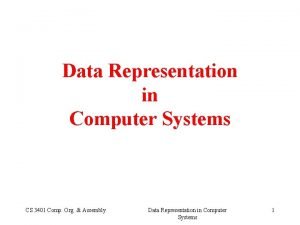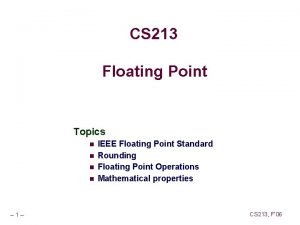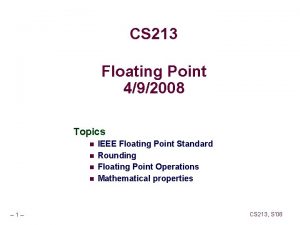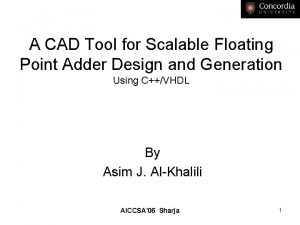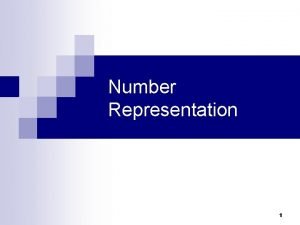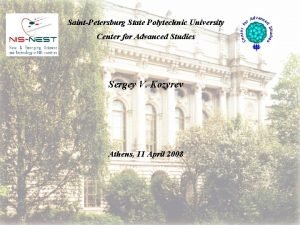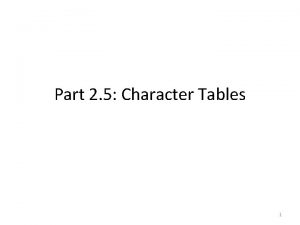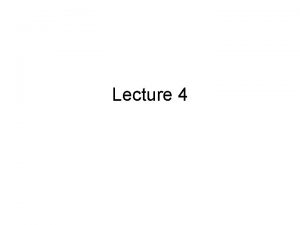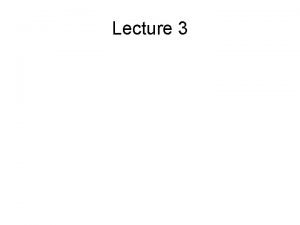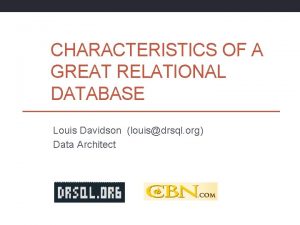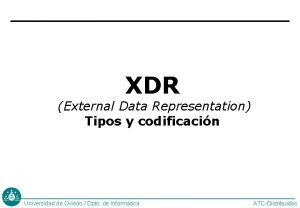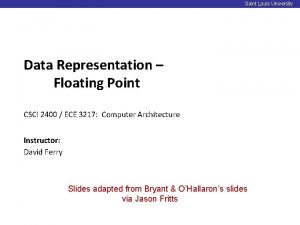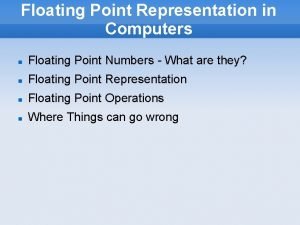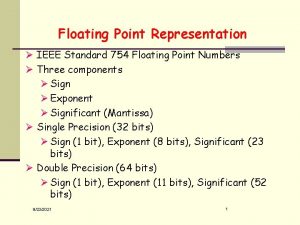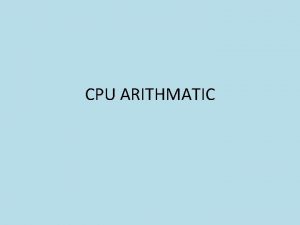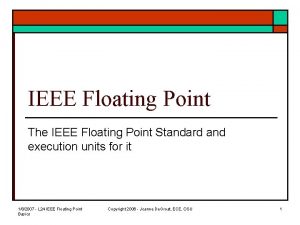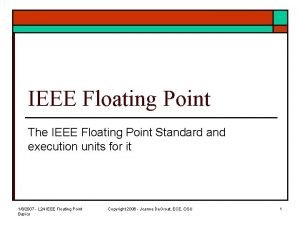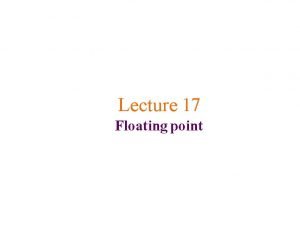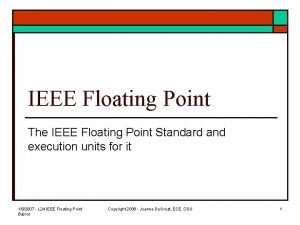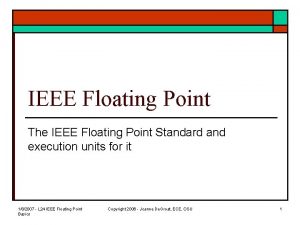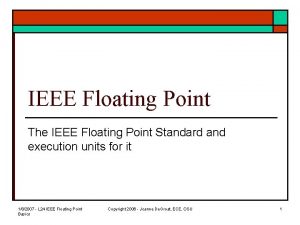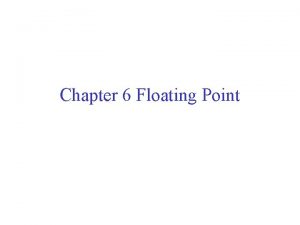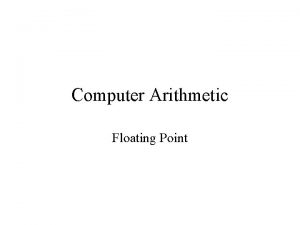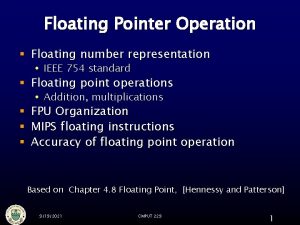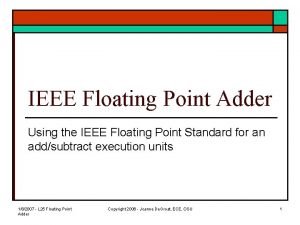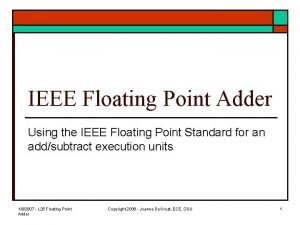Saint Louis University Data Representation Floating Point CSCI

















































- Slides: 49

Saint Louis University Data Representation – Floating Point CSCI 2400 / ECE 3217: Computer Architecture Instructor: David Ferry Slides adapted from Bryant & O’Hallaron’s slides via Jason Fritts

Saint Louis University Today: Floating Point Background: Fractional binary numbers ¢ Example and properties ¢ IEEE floating point standard: Definition ¢ Floating point in C ¢ Summary ¢ 2

Saint Louis University Fractional binary numbers What is 1011. 1012? ¢ How can we express fractions like ¼ in binary? ¢ 3

Saint Louis University Place-Value Fractional Binary Numbers 2 i 2 i-1 22 = 4 21 = 2 20 = 1 • • • bi bi-1 • • • b 2 b 1 b 0 b-1 b-2 b-3 • • • b-j ¢ Representation • • • 2 -1 = 1/2 2 -2 = 1/4 2 -3 = 1/8 2 -j § Bits to right of “binary point” represent fractional powers of 2 § Represents rational number: 4

Saint Louis University Fractional Binary Numbers: Examples 5

Saint Louis University Quick Check ¢ Convert: 255 9⁄16 to binary 101012 to decimal 6

Saint Louis University Quick Check s integer fractional 1 4 -bits 3 -bits 7

Saint Louis University Today: Floating Point Background: Fractional binary numbers ¢ Example and properties ¢ IEEE floating point standard: Definition ¢ Floating point in C ¢ Summary ¢ 8

Saint Louis University Floating Point Representation ¢ 9

Saint Louis University Floating Point Representation ¢ Numerical Form: (– 1)s M 2 E § Sign bit s determines whether number is negative or positive § Significand (mantissa) M normally a fractional value in range [1. 0, 2. 0) § Exponent E weights value by power of two ¢ Encoding § s is sign bit s § exp field encodes E (but is not equal to E) § frac field encodes M (but is not equal to M) s exp frac 10

Saint Louis University Tiny Floating Point Example ¢ s exp frac 1 4 -bits 3 -bits 8 -bit Floating Point Representation § the sign bit is in the most significant bit § the next four bits are the exponent (exp), with a bias of 24 -1 - 1 = 7 § the last three bits are the fraction (frac) ¢ Exponent bias § enable exponent to represent both positive and negative powers of 2 § use half of range for positive and half for negative power § given k exponent bits, bias is then 2 k-1 - 1 11

Saint Louis University Floating Point Encodings and Visualization ¢ Five encodings: § Two general forms: normalized, denormalized § Three special values: zero, infinity, Na. N (not a number) Name Exponent(exp) zero denormalized infinity Na. N −Normalized exp == 0000 < exp < 1111 exp == 1111 −Denorm 0 +Denorm +0 Fraction(frac) frac == 000 frac != 000 +Normalized + Na. N 12

Saint Louis University 0000 001 0000 010 -6 -6 -6 v = (– 1)s M 2 E (Positives)norm: E = Exp – Value Bias 0 1/8*1/64 = 1/512 denorm: E = 1 – closest to zero 2/8*1/64 = 2/512 Bias 0000 0001 110 111 000 001 -6 -6 6/8*1/64 7/8*1/64 8/8*1/64 9/8*1/64 = = 6/512 7/512 8/512 9/512 0110 0111 110 111 000 001 010 -1 -1 0 0 0 14/8*1/2 15/8*1/2 8/8*1 9/8*1 10/8*1 = = = 14/16 15/16 1 9/8 10/8 1110 1111 110 111 000 xxx 7 7 n/a 14/8*128 = 224 15/8*128 = 240 inf Na. N Dynamic Range s exp 0 0 Denormalized 0 … numbers 0 0 … 0 0 0 Normalized numbers 0 0 … 0 0 frac E largest denorm smallest norm closest to 1 below closest to 1 above largest norm infinity Na. N (not a number) 13

Saint Louis University Distribution of Values ¢ 6 -bit IEEE-like format § e = 3 exponent bits § f = 2 fraction bits § Bias is 23 -1 -1 = 3 ¢ (reduced format from 8 bits to 6 bits for visualization) s exp frac 1 3 -bits 2 -bits Notice how the distribution gets denser toward zero. 8 denormalized values (blowup of -1 → 1) 14

Saint Louis University Quick Check ¢ 10 -bit IEEE-like format § e = 5 exponent bits § f = 4 fraction bits ¢ s exp frac 1 5 -bits 4 -bits What is the exponent bias? 15

Saint Louis University Quick Check ¢ s exp frac 1 5 -bits 4 -bits 16

Saint Louis University Quick Check ¢ s exp frac 1 5 -bits 4 -bits 17

Saint Louis University Quick Check ¢ s exp frac 1 5 -bits 4 -bits 18

Saint Louis University Quick Check ¢ s exp frac 1 5 -bits 4 -bits 19

Saint Louis University Quick Check ¢ s exp frac 1 5 -bits 4 -bits 20

Saint Louis University Quick Check ¢ 10 -bit IEEE-like format § e = 5 exponent bits § f = 4 fraction bits ¢ s exp frac 1 5 -bits 4 -bits What is the bit pattern of the smallest positive normal number? 21

Saint Louis University Quick Check ¢ 10 -bit IEEE-like format § e = 5 exponent bits § f = 4 fraction bits ¢ s exp frac 1 5 -bits 4 -bits What is the bit pattern of the smallest positive normal number? § Sign = 0, exp = 00001, frac = 0000; so 0000010000 22

Saint Louis University Quick Check ¢ 10 -bit IEEE-like format § e = 5 exponent bits § f = 4 fraction bits ¢ s exp frac 1 5 -bits 4 -bits What is the bit pattern of the smallest positive normal number? § Sign = 0, exp = 00001, frac = 0000; so 0000010000 ¢ What is the value of the smallest positive normal number? 23

Saint Louis University Quick Check ¢ s exp frac 1 5 -bits 4 -bits 24

Saint Louis University Quick Check ¢ 10 -bit IEEE-like format § e = 5 exponent bits § f = 4 fraction bits ¢ s exp frac 1 5 -bits 4 -bits Given a 32 -bit floating point number, and a 32 -bit integer, which can represent more discrete values? 25

Saint Louis University Quick Check ¢ 10 -bit IEEE-like format § e = 5 exponent bits § f = 4 fraction bits ¢ s exp frac 1 5 -bits 4 -bits Given a 32 -bit floating point number, and a 32 -bit integer, which can represent more discrete values? § Both can represent 232 values, but some bit patterns duplicate values, e. g. +0/-0, + /- , and many Na. Ns (exponent = 11… 1, frac != 00… 0) 26

Saint Louis University Today: Floating Point Background: Fractional binary numbers ¢ Example and properties ¢ IEEE floating point standard: Definition ¢ Floating point in C ¢ Summary ¢ 27

Saint Louis University IEEE Floating Point ¢ IEEE Standard 754 § Established in 1985 as uniform standard for floating point arithmetic Before that, many idiosyncratic formats § Supported by all major CPUs § ¢ Driven by numerical concerns § Nice standards for rounding, overflow, underflow § Hard to make fast in hardware § Numerical analysts predominated over hardware designers in defining standard 28

Saint Louis University Floating Point Representation ¢ Numerical Form: (– 1)s M 2 E § Sign bit s determines whether number is negative or positive § Significand (mantissa) M normally a fractional value in range [1. 0, 2. 0) § Exponent E weights value by power of two ¢ Encoding § s is sign bit s § exp field encodes E (but is not equal to E) § frac field encodes M (but is not equal to M) s exp frac 29

Saint Louis University Precisions ¢ ¢ ¢ Single precision: 32 bits (c type: float) s exp frac 1 8 -bits 23 -bits Double precision: 64 bits (c type: double) s exp frac 1 11 -bits 52 -bits Extended precision: 80 bits (Intel only) s exp frac 1 15 -bits 63 or 64 -bits 30

Saint Louis University Normalized Values ¢ 31

Carnegie Mellon Saint Louis University Normalized Encoding Example ¢ Value: float F = 15213. 0; § 1521310 = 111011012 = 1. 11011012 x 213 ¢ Significand M = frac = ¢ shift binary point by K bits so that only one leading 1 bit remains on the left side of the binary point (here, shifted right by 13 bits, so K = 13), then multiply by 2 K (here, 213) 1. 11011012 1101101000002 Exponent (E = Exp – Bias) E = Bias = Exp = E + Bias = 13 127 140 = 100011002 0 10001100 110110100000 s exp frac 32

Saint Louis University Denormalized Values ¢ Condition: exp = 000… 0 Exponent value: E = –Bias + 1 (instead of E = 0 – Bias) ¢ Significand coded with implied leading 0: M = 0. xxx…x 2 ¢ § xxx…x: bits of frac ¢ Cases § exp = 000… 0, frac = 000… 0 Represents zero value § Note distinct values: +0 and – 0 (why? ) § exp = 000… 0, frac ≠ 000… 0 § Numbers very close to 0. 0 § Lose precision as get smaller § Equispaced § 33

Saint Louis University Special Values ¢ ¢ Special condition: exp = 111… 1 Case: exp = 111… 1, frac = 000… 0 § Represents value (infinity) § Operation that overflows § Both positive and negative § E. g. , 1. 0/0. 0 = − 1. 0/− 0. 0 = + , 1. 0/− 0. 0 = − ¢ Case: exp = 111… 1, frac ≠ 000… 0 § Not-a-Number (Na. N) § Represents case when no numeric value can be determined § E. g. , sqrt(– 1), − , 0 34

Saint Louis University Interesting Numbers {single, double} Description ¢ Zero exp frac 00… 00 Numeric Value 0. 0 Smallest Pos. Denorm. § Single ≈ 1. 4 x 10– 45 § Double ≈ 4. 9 x 10– 324 00… 00 00… 01 2– {23, 52} x 2– {126, 1022} Largest Denormalized § Single ≈ 1. 18 x 10– 38 § Double ≈ 2. 2 x 10– 308 00… 00 11… 11 (1. 0 – ε) x 2– {126, 1022} ¢ ¢ ¢ Smallest Pos. Normalized 00… 01 00… 00 § Just larger than largest denormalized 1. 0 x 2– {126, 1022} One Largest Normalized § Single ≈ 3. 4 x 1038 § Double ≈ 1. 8 x 10308 1. 0 (2. 0 – ε) x 2{127, 1023} 01… 11 00… 00 11… 11 35

Saint Louis University Today: Floating Point Background: Fractional binary numbers ¢ Example and properties ¢ IEEE floating point standard: Definition ¢ Floating point in C ¢ Summary ¢ 36

Saint Louis University Floating Point in C ¢ C Guarantees Two Levels §float §double ¢ single precision double precision Conversions/Casting §Casting between int, float, and double changes bit representation § double/float → int Truncates fractional part § Like rounding toward zero § Not defined when out of range or Na. N: Generally sets to TMin § int → double § Exact conversion, as long as int has ≤ 53 bit word size § int → float § Will round according to rounding mode § 37

Saint Louis University Today: Floating Point Background: Fractional binary numbers ¢ Example and properties ¢ IEEE floating point standard ¢ Rounding, addition, multiplication ¢ Floating point in C ¢ Summary ¢ 38

Saint Louis University Floating Point Operations: Basic Idea ¢ x +f y = Round(x + y) ¢ x f y = Round(x y) ¢ Basic idea § First compute exact result § Make it fit into desired precision Possibly overflow if exponent too large § Possibly round to fit into frac § 39

Saint Louis University Rounding ¢ Rounding Modes (illustrate with $ rounding) $1. 40 $1. 60 $1. 50 $2. 50 –$1. 50 ¢ § § Towards zero Round down (− ) Round up (+ ) Nearest Even (default) $1 $1 $2 $1 $1 $1 $2 $2 $3 $2 –$1 –$2 40

Saint Louis University Closer Look at Round-To-Even ¢ Default Rounding Mode § Hard to get any other kind without dropping into assembly § All others are statistically biased § ¢ Sum of set of positive numbers will consistently be over- or underestimated Applying to Other Decimal Places / Bit Positions § When exactly halfway between two possible values Round so that least significant digit is even § E. g. , round to nearest hundredth 7. 8949999 7. 89 (Less than half way) 7. 8950001 7. 90 (Greater than half way) 7. 8950000 7. 90 (Half way—round up) 7. 8850000 7. 88 (Half way—round down) § 41

Saint Louis University Rounding Binary Numbers ¢ Binary Fractional Numbers § “Even” when least significant bit is 0 § “Half way” when bits to right of rounding position = 100… 2 ¢ Examples § Round to nearest 1/4 (2 bits right of binary point) Value 2 3/32 2 3/16 2 7/8 2 5/8 Binary 10. 000112 10. 001102 10. 111002 10. 101002 Rounded 10. 002 10. 012 11. 002 10. 102 Action (<1/2—down) (>1/2—up) ( 1/2—down) Rounded Value 2 2 1/4 3 2 1/2 42

Saint Louis University Scientific Notation Multiplication ¢ 43

Saint Louis University FP Multiplication (– 1)s 1 M 1 2 E 1 x (– 1)s 2 M 2 2 E 2 s E ¢ Exact Result: (– 1) M 2 ¢ § Sign s: § Significand M: § Exponent E: ¢ s 1 ^ s 2 M 1 x M 2 E 1 + E 2 Fixing § If M ≥ 2, shift M right, increment E § If E out of range, overflow § Round M to fit frac precision ¢ Implementation § Biggest chore is multiplying significands 44

Saint Louis University Scientific Notation Addition ¢ 45

Saint Louis University Floating Point Addition ¢ (– 1)s 1 M 1 2 E 1 + (-1)s 2 M 2 2 E 2 Get binary points lined up §Assume E 1 > E 2 ¢ Exact Result: (– 1)s E 1–E 2 M 2 E §Sign s, significand M: Result of signed align & add §Exponent E: E 1 § ¢ (– 1)s 1 M 1 + (– 1)s 2 M 2 (– 1)s M Fixing §If M ≥ 2, shift M right, increment E §if M < 1, shift M left k positions, decrement E by k §Overflow if E out of range §Round M to fit frac precision 46

Saint Louis University Mathematical Properties of FP Add ¢ Compare to those of Abelian Group Yes § Commutative? § (a + b) = (b + a) § Associative? No Overflow and inexactness of rounding § (3. 14+1 e 10)-1 e 10 = 0, 3. 14+(1 e 10 -1 e 10) = 3. 14 § 47

Saint Louis University Mathematical Properties of FP Mult ¢ Compare to Commutative Ring § Multiplication Commutative? § Ex: (1 e 20*1 e-20)=(1 e-20*1 e 20) Yes § Multiplication is Associative? No Possibility of overflow, inexactness of rounding § Ex: (1 e 20*1 e 20)*1 e-20= inf, 1 e 20*(1 e 20*1 e-20)= 1 e 20 § § Multiplication distributes over addition? No Possibility of overflow, inexactness of rounding § 1 e 20*(1 e 20 -1 e 20)= 0. 0, 1 e 20*1 e 20 – 1 e 20*1 e 20 = Na. N § 48

Saint Louis University Summary ¢ ¢ Represents numbers of form M x 2 E One can reason about operations independent of implementation § As if computed with perfect precision and then rounded ¢ Not the same as real arithmetic § Violates associativity/distributivity § Makes life difficult for compilers & serious numerical applications programmers 49
 Fixed point
Fixed point Vamc slums examination
Vamc slums examination Slu core values
Slu core values Slu irb
Slu irb Saint louis university madrid
Saint louis university madrid Saint louis university madrid
Saint louis university madrid Floating point multiplication flowchart
Floating point multiplication flowchart Floating point number system
Floating point number system Floating point number representation
Floating point number representation Floating point representation
Floating point representation Ieee
Ieee Floating point representation
Floating point representation Two's complement representation
Two's complement representation Patron saint for throat problems
Patron saint for throat problems Le souverain sacrificateur dans le lieu très saint
Le souverain sacrificateur dans le lieu très saint Annes babes house
Annes babes house Gondrand fos sur mer
Gondrand fos sur mer Colegio saint louis school
Colegio saint louis school Louis vuitton history timeline
Louis vuitton history timeline Data representation in computer organization
Data representation in computer organization Fp adder
Fp adder Convert to floating point
Convert to floating point Mult mips
Mult mips Bit4bytes
Bit4bytes Ieee denormalized numbers
Ieee denormalized numbers What are floating point numbers
What are floating point numbers Shift and add multiplication
Shift and add multiplication Eascii
Eascii Parts of a floating point number
Parts of a floating point number Pentium pipeline stages
Pentium pipeline stages Xkcd floating point
Xkcd floating point Dfa for floating point numbers
Dfa for floating point numbers Eecs370
Eecs370 Express (32)10 in the revised 14-bit floating-point model
Express (32)10 in the revised 14-bit floating-point model Floating point form
Floating point form Floating point puzzles
Floating point puzzles Floating point puzzles
Floating point puzzles Compound adder
Compound adder Integer
Integer Floating point arithmetic examples
Floating point arithmetic examples Saint petersburg state polytechnical university
Saint petersburg state polytechnical university Saint leo university residence life
Saint leo university residence life Saint petersburg electrotechnical university
Saint petersburg electrotechnical university Slu family medicine residency
Slu family medicine residency Decimal fixed point representation
Decimal fixed point representation Character table d infinity h
Character table d infinity h C3v multiplication table
C3v multiplication table S2n axis
S2n axis What is this
What is this Xdr external data representation
Xdr external data representation
